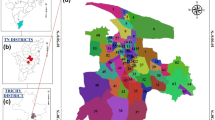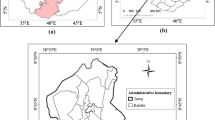Abstract
This study aims to evaluate current locations of preschool education institutions and suggest alternative spatial arrangements in the Afyonkarahisar province in Turkey, using heuristic location-allocation modelling approaches to improve overall spatial accessibility. The population totals were generated by supplying a unique code for each spatial unit. The census information was joined with a vector layer to transfer the population values to source units. In order to better predict the school age population distribution structure within the source zones, an intelligent areal interpolation approach was performed. The digital boundaries of the central district and villages of the Afyonkarahisar province were used as the source zones. The population surfaces of the source units were modelled by using the Corine Land use/cover (2018 dated) dataset and dasymetric mapping method. The gridded population surface model with population estimates and 1199 grid points across the province were used to model the preschool aged population in need of preschool educational services. With the current distribution of preschools in Afyonkarahisar, the preschool aged population would have to travel an average distance of 4629.49 m to access the closest preschool to them. The results of this study show that the provision of alternative preschool locations decreased the average travel distance from each residential home to each preschool by 626.82 m, thereby improving overall accessibility to preschools.







Similar content being viewed by others
References
Alshwesh, I.O.A. (2014). GIS-based interaction of location allocation models with areal interpolation techniques (Unpublished doctoral dissertation). University of Leicester. https://hdl.handle.net/2381/28594.
Apparicio, P., Abdelmajid, M., Riva, M., & Shearmur, R. (2008). Comparing alternative approaches to measuring the geographical accessibility of urban health services: Distance types and aggregation-error issues. International Journal of Health Geographics, 7(7), 1–14.
Bejleri, I., Steiner, R. L., Fischman, A., & Schmucker, J. M. (2011). Using GIS to analyze the role of barriers and facilitators to walking in children’s travel to school. Urban Design International, 16(1), 51–62.
Black, M., Ebener, S., Aguilar, P. N., Vidaurre, M., & El Morjani, Z. (2004). Using GIS to measure physical accessibility to health care. In ESRI 2004 international health conference proceedings. World Health Organization.
Bozkaya, B., Yanik, S., & Balcisoy, S. (2010). A GIS-based optimization framework for competitive multi-facility location-routing problem. Networks and Spatial Economics, 10, 297–320. https://doi.org/10.1007/s11067-009-9127-6.
Brock, C. (2013). The geography of education and comparative education. Comparative Education, 49(3), 275–289.
Burgess, S., Greaves, E., Vignoles, A., & Wilson, D. (2011). Parental choice of primary school in England: What types of school do different types of family really have available to them? Policy Studies, 32(5), 531–547.
Châu, T.-N. (2003). Demographic aspects of educational planning. International Institute for Educational Planning: UNESCO.
Chillón, P., Panter, J., Corder, K., Jones, A. P., & Van Sluijs, E. M. F. (2015). A longitudinal study of the distance that young people walk to school. Health & Place, 31, 133–137.
Creswell, J. W., & Creswell, J. D. (2018). Research design: Qualitative, quantitative, and mixed methods approaches (5th ed.). Los Angeles: SAGE.
Drezner, Z. (1995). Facility location: A survey of applications and methods. New York: Springer Verlag.
Edmark, K., Frölich, M., & Wondratschek, V. (2014). Sweden’s school choice reform and equality of opportunity. Labour Economics, 30, 129–142.
Fox, M. (1996). Rural school transportation as a daily constraint in students’ lives. Rural Educator, 17, 22–27.
Gibson, J., Deng, X., Boe-Gibson, G., Rozelle, S., & Huang, J. (2011). Which households are most distant from health centres in rural China? Evidence from a GIS network analysis. GeoJournal, 76, 245–255.
Gilliland, J. A., Shah, T. I., Clark, A., Sibbald, S., & Seabrook, J. A. (2019). A geospatial approach to understanding inequalities in accessibility to primary care among vulnerable populations. PLoS One, 14(1), e0210113. https://doi.org/10.1371/journal.pone.0210113.
Gulosino, C., & Lubienski, C. (2011). School’s strategic responses to competition in segregated urban areas: Patterns in school locations in metropolitan Detroit. Education Policy Analysis Archives, 19(13), 1–29.
Hesapcioglu, M. (2006). Cumhuriyet dönemi Türkiye’de eğitim planlaması çalışmaları [Educational planning efforts in Turkey in republic period]. In M. Hesapcioglu & A. Durmus (Eds.), Türkiye’de eğitim bilimleri: Bir bilanço denemesi [Educational sciences in Turkey: A statement trial] (pp.107–124). Ankara: Nobel.
Higgs, G. (2004). A literature review of the use of GIS-based measures of access to health care services. Health Services & Outcomes Research Methodology, 5, 119–139.
Higgs, G., Fry, R., & Langford, M. (2012). Investigating the implications of using alternative GIS-based techniques to measure accessibility of green space. Environment and Planning B: Planning and Design, 39, 326–343. https://doi.org/10.1068/b37130https://mebbis.meb.gov.tr/KurumListesi.aspx, retrieved on 01.02.2020.
Jega, I. M. (2015). Estimating population surfaces in areas where actual distributions are unkown: Dasymetric mapping and pycnophylactic interpolation across different spatial scales [Unpublished doctoral dissertation]. University of Leicester.
Jega, I. M., Comber, A., & Brundson, C. (2012). Population estimation in small areas: Combining dasymetric mapping with pycnophylactic interpolation. Paper presented at GISRUK 2012 Proceedings. United Kingdom: Lancester University.
Jega, I. M., Comber, A. J., & Tate, N. J. (2017). Spatial planning under data paucity: Dasymetric interpolation of population, validated by Google earth, to support health facility location modelling. SSRG International Journal of Geoinformatics and Geological Science, 4(3), 1–11.
Jia, H., Ordonez, F., & Dessouky, M. (2007). A modelling framework for facility location of medical services for large-scale emergencies. IIE Transactions, 39, 41–45.
Jones, S. G., Ashby, A. J., Momin, S. R., & Naidoo, A. (2010). Spatial implications associated with using Euclidean distance measurements and geographic centroid imputation in health care research. Health Services Research, 45(1), 316–327.
Kelly, M. G. (2019). A map is more than just a graph: Geospatial educational research and the importance of historical context. AERA Open, 5(1), 1–14. https://doi.org/10.1177/2332858419833346.
Kucukturan, A. G. (2006). Türkiye’de cumhuriyet döneminde okul öncesi eğitim [preschool education in Turkey in republican period]. In M. Hesapcioglu & A. Durmus (Eds.), Türkiye’de eğitim bilimleri: Bir bilanço denemesi [Educational sciences in Turkey: A statement trial] (pp. 107–124). Ankara: Nobel.
Langford M. (2004) Populated pixel maps: A simple method to facilitate dasymetric areal interpolation. Proceedings of the 12th Annual GIS Research UK Conference, University of East Anglia, UK. pp370–372.
Langford, M. (2005). Dasymetric mapping of industry and commerce across Wales, UK, using geospatial integration of national mapping agency products [online]. http://www.acsm.net/sessions05/langford05.pdf.
Langford, M., & Higgs, G. (2006). Measuring potential access to primary healthcare services: The influence of alternative spatial representations of population. The Professional Geographer, 58(3), 294–306. https://doi.org/10.1111/j.1467-9272.2006.00569.x.
Lubienski, C., & Dougherty, J. (2009). Mapping educational opportunity: Spatial analysis and school choices. American Journal of Education, 115(4), 485–491.
Lubienski, C., Lee, J., & Gordon, L. (2013). Self-managing schools and access for disadvantaged students: Organizational behaviour and school admissions. New Zealand Journal of Educational Studies, 48(1), 82–98.
Mann, B., & Saultz, A. (2019). The role of place, geography, and geographic information systems in educational planning. AERA Open, 5(3), 1–15. https://doi.org/10.1177/2332858419869340.
Mennis, J. (2009) Dasymetric mapping for estimating population in small areas. Geography Compass, 3(2), 727–745.
McGregor, J., Hanlon, N., Emmons, S., Voaklander, D., & Kelly, K. (2005). If all ambulances could fly: Putting provincial standards of emergency care access to the test in northern British Columbia. Canadian Journal of Rural Medicine, 10, 163–168.
Mindahun, W., & Asefa, B. (2019). Location allocation analysis for urban public services using GIS techniques: A case of primary schools in Yeka sub-city, Addis Ababa, Ethiopia. American Journal of Geographic Information System, 8(1), 26–38.
Ministry of National Education (MoNE). (2014). Pre-School Education and Primary Education Institutions Regulation. Official Gazette (Number: 29072). Retrieved from: https://www.mevzuat.gov.tr/Metin.Aspx?MevzuatKod=7.5.19942&MevzuatIliski=0&sourceXmlSearch=okul%20%C3%B6ncesi
National Education Statistics. (2019). National Education Statistics: Formal Education 2018/‘19. http://sgb.meb.gov.tr/meb_iys_dosyalar/2019_09/30102730_meb_istatistikleri_orgun_egitim_2018_2019.pdf
Ndiaye, F., Ndiaye, B. M., & Ly, I. (2012). Application of the p-median problem in school allocation. American Journal of Operations Research, 2, 253–259. https://doi.org/10.4236/ajor.2012.22030.
Newby, P. (2014). Research methods for education (2nd ed.). Routledge.
Nooradelena, M. R., & Noraida, A. G. (2006). An application of the p-median problem with uncertainty in demand in emergency medical services. In Proceedings of the 2nd IMT-GT Regional Conference on Mathematics, Statistics and Applications, 13–15 June. Penang: Universiti Sains Malaysia.
Presidency of Turkish Republic. (2019). Presidency of Turkish Republic yearly plan for 2020. http://www.sbb.gov.tr/wp-content/uploads/2019/11/2020_Yili_Cumhurbaskanligi_Yillik_Programi.pdf
Richards, M. (2014). The gerrymandering of school attendance zones and the segregation of public schools: A geospatial analysis. American Educational Research Journal, 51, 1119–1157.
Saporito, S., & Sohoni, D. (2006). Coloring outside the lines: Racial segregation in public schools and their attendance boundaries. Sociology of Education, 79(2), 81–105.
Sasaki, S., Igarashi, K., Fujino, Y., Comber, A. J., Brunsdon, C., Muleya, C. M., Suzuki, H. (2011). The impact of community-based outreach immunisation services on immunisation coverage with GIS network accessibility analysis in Peru-urban areas, Zambia. Journal of Epidemiol Community Health, 65, 1171–1178.
Schultz, L. (2014). Inequitable dispersion: Mapping the distribution of highly qualified teachers in St. Louis metropolitan public elementary schools. Educational Policy Analysis and Archives, 22(90), 1–24.
Scott, B. D. (1999). Standing up for community and school: Rural people tell their stories. Randolph: The Rural Challenge Policy Program.
Shapiro, A., Martin, E., Weiland, C., & Unterman, R. (2019). If you offer it, will they come? Patterns of application and enrollment behavior in a universal prekindergarten context. AERA Open, 5(2), 1–22. https://doi.org/10.1177/2332858419848442.
Sharkey, P. (2013). Stuck in place: Urban neighborhoods and the end of progress toward racial inequality. Chicago: University of Chicago Press.
Talen, E. (2001). School, community, and spatial equity: An empirical investigation of access to elementary schools in West Virginia. Annals of the Association of American Geographers, 91(3), 465–486. https://doi.org/10.1111/0004-5608.00254.
Taylor, C. (2002). Geography of the “new” education market: Secondary school choice in England and Wales. Aldershot: Ashgate.
Taylor, C. (2009). Choice, competition, and segregation in a United Kingdom urban education market. American Journal of Education, 115(4), 549–568.
Teacher Strategy Paper. (2017). Teacher strategy paper: 2017–2023. Directorate General for Teacher Training and Development. https://oygm.meb.gov.tr/meb_iys_dosyalar/2018_05/25170118_Teacher_Strategy_Paper_2017-2023.pdf
Teitz, M. B., & Bart, P. (1968). Heuristic methods for estimating the generalized vertex median of a weighted graph. Operations Research, 16(5), 955–961.
Tomintz, M., Clarke, G., Rigby, J., & Green, J. (2013). Optimising the location of antenatal classes. Midwifery, 29, 33–43.
UNESCO. (2020). Out-of-school children and youth. Retrieved 18 October, 2020, from http://uis.unesco.org/en/topic/out-school-children-and-youth
Witham, M. (1997). The economics of (not) closing small rural schools. Paper presented at Symposium on the Doctor of Philosophy for Candidates and Supervisors: A Focus on Rural Issues, held in Townsville, Queensland, Australia, July 1997. https://files.eric.ed.gov/fulltext/ED415036.pdf.
Wong, B.YM., Faulkner, G., & Buliung, R. (2011). GIS measured environmental correlates of active school transport: A systematic review of 14 studies. International Journal of Behavioral Nutrition and Physical Activity, 8, 1–22. http://www.ijbnpa.org/content/8/1/39
Yoon, E.-S., Gulson, K., & Lubienski, C. (2018). A brief history of the geography of education policy: Ongoing conversations and generative tensions. AERA Open, 4(4), 1–9. https://doi.org/10.1177/2332858418820940.
Zhang, H., & Cowen, D. (2009). Mapping educational achievement and public school under the no child left behind legislation. Southern Geographer, 49, 24–40.
Author information
Authors and Affiliations
Corresponding author
Additional information
Publisher’s note
Springer Nature remains neutral with regard to jurisdictional claims in published maps and institutional affiliations.
Rights and permissions
About this article
Cite this article
Köse, M., Koçyiğit, M., Erdem, C. et al. An evaluation of accessibility to preschool education institutions using geographic information systems. Educ Inf Technol 26, 4307–4328 (2021). https://doi.org/10.1007/s10639-021-10482-7
Received:
Accepted:
Published:
Issue Date:
DOI: https://doi.org/10.1007/s10639-021-10482-7




